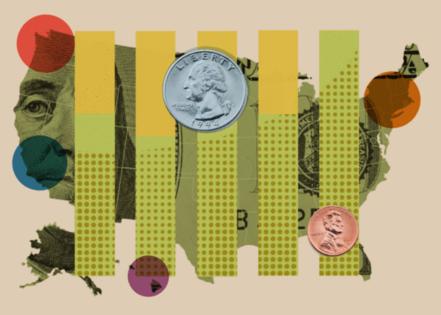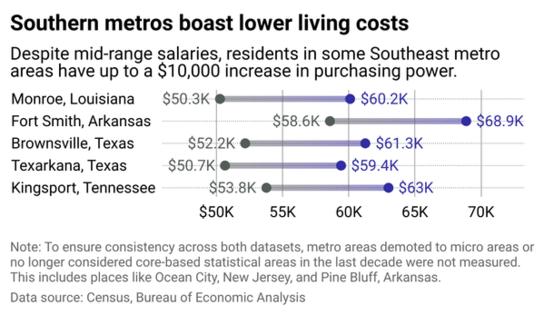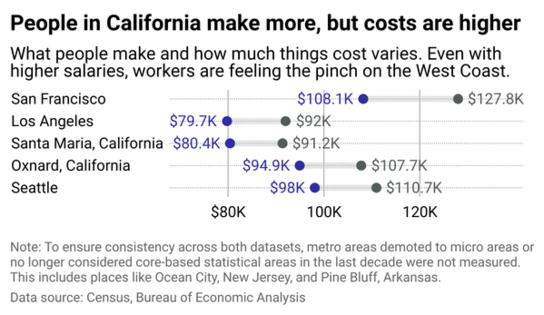What a difference a dollar makes: These are the metros where your paycheck stretches the furthest
Published in Slideshow World
Subscribe
What a difference a dollar makes: These are the metros where your paycheck stretches the furthest
It's getting hard out there to be an everyday consumer. Prices are up, and so is unemployment. President Donald Trump's shifting positions on tariffs are contributing to a haze of economic uncertainty. Bracing for impact, shoppers are trimming their grocery runs and seeking discounts, and their confidence in the economy is plunging, according to The Conference Board. Wage growth has been slowing, and job seekers are heading into a job market downturn as businesses pause hiring in the face of an anxious forecast and rising recession fears. Savers are counting their pennies, and kitchen table economics are getting trickier.
That said, it's as important as ever for workers and families to ensure their dollars buy the most they can. Still, that's not the same nationwide. Some cities are more expensive, and others are more affordable. One economic measurement of this is "price parity," determined as a percentage of each year's overall national price level. A metro with a regional price parity, or RPP, of 100 has goods and services equal to the national price. One with an RPP of 110 costs 10% more than the national level, while one with an RPP of 83 is 83% of the national level. Certain areas are more expensive than others due to various factors, including demand for housing and rent, local wages, taxes, and transportation.
Median household income is the dividing line where half of households earn more than that amount and half earn less. Some people get paid more in certain parts of the country. That area may have a greater concentration of high-paying jobs. Those jobs may require higher-skilled workers, or there may be a high demand for them. If the cost of living is higher, employees will have a cost-of-living adjustment, giving them a higher salary than a worker living across the country in a more affordable area. Regions experiencing faster growth will have more competitive labor markets, and companies must offer higher wages to attract workers.
Purchasing power is whatyour dollars can buy in your local economy. In Seattle, where the median household income is about $110,000, the cost of living is about 13% more expensive than average in the United States, meaning a six-figure median income feels closer to just $93,000.
Geography matters. The islands of Hawai'i are more expensive because many goods have to be imported, and there are fewer retailers. Due to this, $1,000 only buys you about $920 of goods and services, according to a Bureau of Economic Analysis price comparison. In California, $1,000 equals $888; in Washington D.C, it's only $902.
Wealth Enhancement compared median incomes and price parity data from the BEA to examine metros where a paycheck goes the farthest and where it doesn't feel like it goes very far at all.
Visit thestacker.com for similar lists and stories.
Money stretches further in these 5 places
The financial geography of America shows there are zones where modest incomes translate into larger lifestyle gains. While Southern households earn less on paper, $73,280 in 2023 versus the national median of $80,610, according to the Peter G. Peterson Foundation's analysis of Census Bureau data, their money performs better at the cash register thanks to lower regional price parities.
Take Fort Smith, Arkansas, a manufacturing and health care hub. As of March 12, 2025, gas pumps show $2.74 per gallon versus the national $3.09 average, giving drivers a 12% discount every time they fill up. A dozen large eggs at Aldi rings up at $6.59, undercutting the national wholesale average of $6.85 as of March 7. The real discounts, however, are seen in housing, where average rents run just $1,000 monthly as of March 11, according to Zillow—barely half the national average of $2,050.
Kingsport, Tennessee, tells a similar story. Health care, manufacturing, and education power the local economy, while gas prices as of March 12 cost $2.74 per gallon. A dozen large eggs at Food City will run you $6.99. At $1,300 monthly on average, housing still delivers a substantial $750 monthly discount versus the national norm.
These price differentials explain why many Southerners living on seemingly modest incomes might enjoy more disposable income. The raw numbers on a paycheck only tell half the story. What those dollars can buy determines the relative degree of financial comfort.
Despite high salaries, the cost of living takes a toll in these places
The tug of the West Coast's economic rip current makes higher paychecks feel smaller. As of March 12, San Francisco residents shell out $9.99 for a dozen eggs and $4.85 per gallon at the pump. The average rent is an eye-popping $3,195 monthly. In Los Angeles, where entertainment and logistics drive the local economy, prices are also toasty: $9.99 eggs, $4.68 gas, and $2,748 monthly rent can quickly eat up paychecks. The math reveals why so many six-figure earners still feel cash-strapped. Higher regional price parities in these metros effectively downsize those impressive salaries.
The where-to-live equation isn't just about mortgage payments and receipts. Sure, savvy consumers crunch numbers on the full financial picture, calculating and comparing the various taxes, commutes, insurance, and groceries between ZIP codes. Still, life can't be boiled down to just a spreadsheet. People might want to live near family for closeness and help with child care. Others might need nearby nature access to regain peace on the weekends or to be in the right school district for their kids.
As part of deciding to move, consider the regional price parities and the return on happiness. A longer commute might allow you to live in a bigger house or quieter, nature-filled neighborhood, but that drive will shave hours off your life each week. Even a remote job can be stressful in terms of feeling socially or professionally isolated. One good idea is to try renting near where you're thinking of living for a week or weekend and see what it's like to be in the rhythm of the neighborhood. What makes a house a home is a balance of lifestyle and affordability.
Story editing by Carren Jao. Copy editing by Paris Close.
This story originally appeared on Wealth Enhancement and was produced and distributed in partnership with Stacker Studio.









Comments